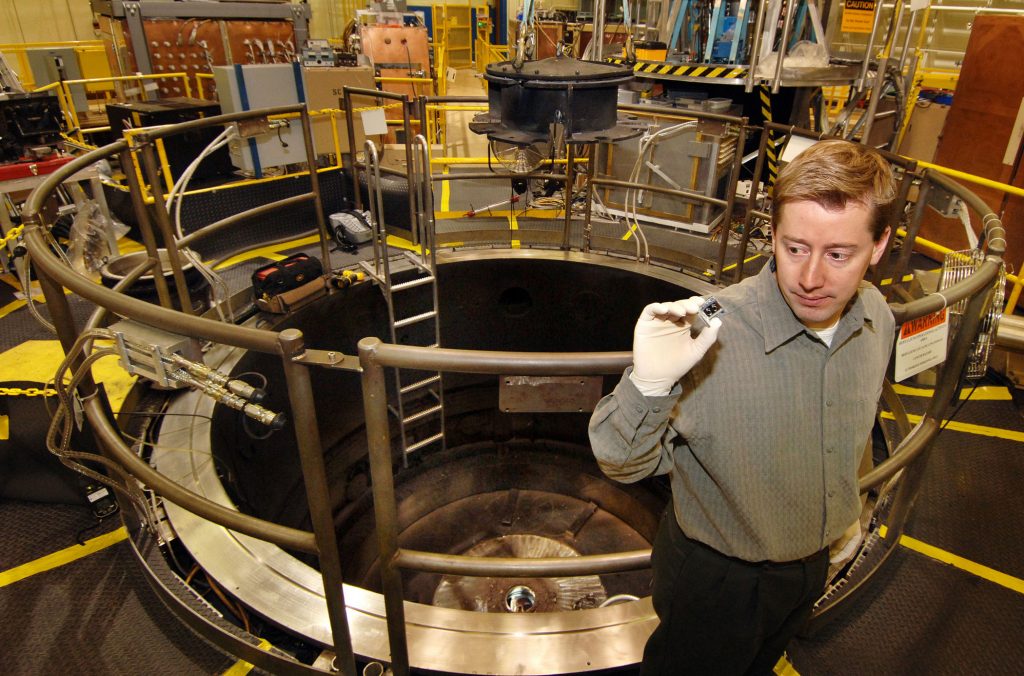Technique helps compute Jupiter/Saturn mass, improve peacetime fusion capsule design, stabilize stockpile

Download 300dpi JPEG image, “z-supershooter.jpg,” 712K (Media are welcome to download/publish this image with related news stories.)
ALBUQUERQUE, N.M. — Sandia National Labs has accelerated a small plate from zero to 76,000 mph in less than a second.
The speed of the thrust was a new record for Sandia’s Z Machine — sometimes referred to as the fastest gun in the West. Actually the fastest in the world, it is now able to propel small plates at 34 kilometers a second, faster than the 30 km/sec that Earth travels through space in its orbit about the sun, 50 times faster than a rifle bullet, and three times the velocity needed to escape Earth’s gravitational field.
Sandia is a National Nuclear Security Administration lab.
The immediate purpose of these very rapid flights is to help understand the extreme conditions found within the interiors of the giant planets Saturn and Jupiter, hasten the achievement of virtually unlimited energy through peacetime atomic fusion, and provide more information about the condition of the U.S. nuclear stockpile without having to explode a nuclear weapon.
“This is one of the few ways on earth to get hard information on problems at the outer reaches of science, rather than having to rely on complex speculations that may or may not be correct,” says Marcus Knudson, lead scientist on the effort.

Download 300dpi JPEG image, “z-tech.jpg,” 644K (Media are welcome to download/publish this image with related news stories.)
Z’s hurled plates strike a target after traveling only five millimeters. The impact generates a shock wave — in some cases, reaching 15 million times atmospheric pressure — that passes through the target material. The waves are so powerful that they turn solids into liquids, liquids into gases, and gases into plasmas in the same way that heat melts ice to water or boils water into steam.
The difference is that the process takes place at far higher temperatures and in much shorter times than the kitchen stove could ever approach. The pressures produce states of materials rarely seen or measured in the laboratory. Says Yogi Gupta, a professor known for his work in shock physics at the Washington State University in Pullman, “If you had asked me a few years ago if we could send something this fast, I would have said you were joking. But mankind is always trying to create conditions in the laboratory that imitate extreme conditions [found elsewhere].”
When shock waves penetrate a capsule containing deuterium (an isotope of hydrogen), researchers learn more about how hydrogen behaves under extreme conditions, providing more information for humanity’s effort to eventually achieve controlled nuclear fusion, the process that drives the sun. Harnessed in a power plant, this potentially low-environmental-impact method could achieve virtually unlimited energy from sea water.
By creating states of matter extremely difficult to achieve on Earth, the flyer plates also provide hard data to astrophysicists speculating on the structure and even the formation of planets like Jupiter and Saturn. Says Didier Saumon, an astrophysicist at Los Alamos National Laboratory, “The internal structures of Jupiter and Saturn are composed mostly of hydrogen, so knowing its equation of state [how hydrogen and its isotopes behave at pressures from one to 50 million atmospheres] is highly relevant to how we infer the interior properties of these planets. Z gave us hard data.”
A paper on the flyer plate results, first presented in a technical talk to the American Physical Society, has been submitted to the Journal of Applied Physics.
More technical information
The plates are small — only 30 mm by 15 mm in cross-section, and 850 microns thick. The trick in accelerating the fragile aluminum plates at 10-to-the-10th Gs (force of Earth’s gravity) without vaporizing them lies in the finer control now achievable of the magnetic field pulse driving the flight.
The arrival of energy at the target is staggered over three hundred nanoseconds, so that the amperage arrives less like a brick wall that would vaporize the plate and more in controllable increments.
This requirement was better achieved by a recent upgrade that removed a single laser formerly used to trigger current in Z’s thirty-six cables simultaneously. In its place, 36 laser switches were installed — one for each cable. This change permits researchers to shape the electrical pulse that arrives at the target, with a corresponding modulation in the magnetic field driving the plate.
An upgrade of Z planned for next year is expected to achieve plate velocities of 45 to 50 km/sec, says Marcus, driving targeted materials further into their plasma regime.
Z’s former record in propelling plates was 21 km/sec, set two years ago.